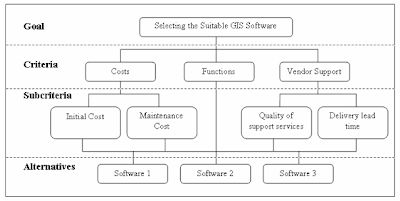Introduction
In this paper, the author Khalid Eldrandaly elaborates on how MCDM is the most effective methodology for Geographic Information System software selection. The author’s overall goal was to provide a framework that assists computer system developers to select the most appropriate GIS software application for their organization.
Summary
In this paper, the author projects the application of the MCDM technique to select the most appropriate GIS software to purchase or invest in, that best fits an organization’s needs. According to the author, “a multi criteria decision problem generally involves choosing one of several alternatives based on how well those alternatives rate against a chosen set of structured and weighted criteria.” The author simplifies the GIS software selection process as follows:
- Ø Brainstorm the problem
- Ø Build the hierarchy
- Ø Rate the hierarchy
- Ø Select the best alternative
The author identifies the analytic hierarchy process (AHP), a type of MCDM, as the most effective method in selecting GIS software. The AHP method allows the consideration of both objective and subjective factors in selecting the best alternative, and reduces time and develops consensus for decision making. In order to apply the technique, one should define the different factors and requirements of the project, and then narrow down the different GIS software that meets the most requirements.
According to the author, the hierarchy process is based on three principles: decomposition, comparative judgments, and synthesis of priorities. In developing a hierarchy, the top level is the ultimate goal of the decision at hand. The author uses the figure 1 (below) to illustrate the four-level hierarchical structure of a simplified GIS software selection decision making problem.
 |
| Figure 1 |
Once the goal or requirement is established, it is necessary to identify the factors that influence the choice of GIS software. The author identified five essential evaluation criteria to use for the decision making process:
- Cost: The expenditure associated with GIS software and includes product, license, training, maintenance, software subscription, and support services costs.
- Functionality: Refers to extent to which the software package contains all the features and functions specified in your request for proposal (RFP) which is generated based on the organization needs assessment.
- Reliability
- Usability: Usability is the effectiveness, efficiency and satisfaction with which specified users can achieve specified goals in particular environments; Understandability, Learnability, and Operability
- Vendor: The quality of vendor support and its characteristics are of major importance in the selection of software.
Once the criteria are set, judging the importance of criteria and scoring alternatives need to be developed. There are two methods for weighing; direct comparison or pair-wise comparison. After weighing the criteria, the author suggests using MCDM software to list the different GIS software available, and then assign & rate the different criteria to each GIS software; as shown in figure 2.
 |
| Figure 2 |
Source:
Eldrandaly, K. (2007) – GIS Software Selection; a multi-criteria decision making approach. Retrieved from



No comments:
Post a Comment